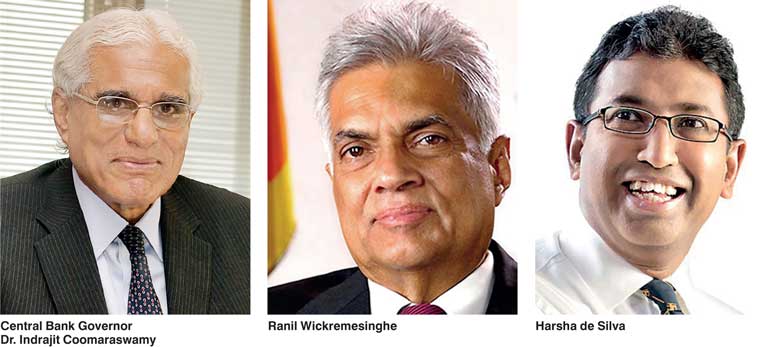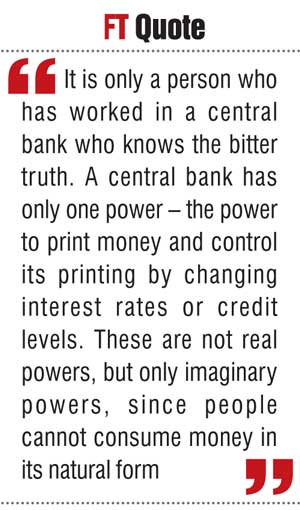Thursday Jan 08, 2026
Thursday Jan 08, 2026
Monday, 9 April 2018 00:10 - - {{hitsCtrl.values.hits}}

Partial and cautious relaxation of monetary policy
The Central Bank in its second monetary policy review in 2018, released last week, has cautiously and partially relaxed the tight policy package it had introduced earlier when inflation was rearing its ugly head causing chaos to investment initiatives in the country (available at: https://www.cbsl.gov.lk/sites/default/files/cbslweb_documents/press/pr/press_20180404_Monetary_Policy_Review_No_2_2018_e_U45p3.pdf).
Accordingly, it has reduced the interest rate which it charges when cash-short commercial banks borrow from it to meet temporary cash shortages – known as Standing Lending Facility – by a quarter of a percent from 8.75% to 8.50%.
However, it has kept the interest rate which it has to pay to commercial banks with cash surpluses when they temporarily park their surpluses with it – known as Standing Deposit Rate – unchanged at 7.25%. The net outcome has been to narrow the gap between these two rates from the previous 1.5% to 1.25%.
The other monetary policy instrument – Statutory Reserve Ratio or the minimum amount of cash which commercial banks should compulsorily keep with the Central Bank based on the  deposits they hold – has been kept unchanged at 7.5%. Thus, the policy change has been both cautious and partial.
deposits they hold – has been kept unchanged at 7.5%. Thus, the policy change has been both cautious and partial.
Measure is expected to stimulate economy by lowering lending rates
Commercial banks have to use the Standing Lending Facility as the last resort when all other sources of raising temporary funds have exhausted. For instance, they are expected to meet the temporary cash shortages by borrowing from cash-rich corporate entities, selling the Treasury bills or bonds they hold in the REPO market and from among themselves, known as the Interbank Call Money Market.
If there are no more funds in these sources, they have been given the facility by the Central Bank to borrow under the Standing Lending Facility. Hence, it represents the marginal cost of banks and when that cost goes down, it enables the banks to cut their lending rates as well. Hence, the measure is expected to stimulate growth by lowering the lending rates of banks. Since there is no change in the Standing Deposit Rate, the Central Bank expects that banks will not reduce the interest rates they pay to their depositors.
CB has given a signal to the market
The relaxation of policy is just by an insignificant 25 basis points, so called because it is 0.25% of one full percent which contains 100 such basis points. Hence, the effect is expected to work by giving a strong signal to the market.
The signal is that the slowing economy is worrisome, the bank is ready to give relief through a cautious reduction in interest rates, there are bigger problems in the economy outside its control such as the stubborn budget, stagnant exports and ballooning imports and the real challenge is to complete the reform program to put the economy back on the long-term growth path.
The justification of the bank’s cautious move was done in the press briefing by its Director of Economic Research in English and the Deputy Directors of Economic Research, one in Sinhala and the other in Tamil (available at: https://www.youtube.com/watch?v=DNxb9_s3low&t=1236s).
Unfortunately, both the press release and the press briefing are full of technical jargons which even the vociferous all-knowing Parliamentarians would not be able to comprehend unless they get the support of a tutor. But it is the way of central bankers throughout the globe to speak a language which is perhaps understood only by those who speak it.
CB cannot create wealth
There is a general belief harboured by many, including some of the mainstream economists and politicians who the central bank’s duty is to design and implement economic policies to help people become richer. Hence, they very quickly blame the central bank when the actual production of goods and services, known as Gross Domestic Product or GDP, slows down disappointing those who had expected a quick path to richness.
Even the former Minister of Finance, Ravi Karunanayake who was named the best Minister of Finance in Asia and the Pacific, has been continuously blaming the Central Bank, both while in office and out, for the present economic crisis in the country (available at: http://www.thecolombopost.net/en/ravi-karunanayake-blamed-the-central-bank). This writer has the experience of his students, both at the undergraduate and postgraduate levels, echoing the sentiments similar to what the former minister of finance has been making in public.
It is only a person who has worked in a central bank who knows the bitter truth. A central bank has only one power – the power to print money and control its printing by changing interest rates or credit levels. These are not real powers, but only imaginary powers, since people cannot consume money in its natural form.
For that, they have to convert that money into real goods and services at rates known as the money prices. If money is aplenty compared to the real goods and services available in the market, the prices will increase leaving no real effect on those who hold onto money.
Growth is the responsibility of the Government
In a market, this part of control which a central bank does falls into the demand side. When one looks at the whole economy, it is called the total demand or aggregate demand. The other side of the coin is the total supply, also known as the aggregate supply. It comes, not from money but, as the first Minister of Finance in Singapore – Dr. Goh Keng Swee – put it, from “the hard work done by students at schools, undergraduates at universities and workers at work places”.
In today’s Sri Lanka’s context, the hard work requirement can be extended to businessmen on the private sector side and to Prime Ministers, Ministers, State Ministers, Parliamentarians and civil servants on the government side. It is the duty of those who hold the reins of government to create conditions conducive for people to work hard by appropriately rewarding them for their honest efforts and reprimanding those who are bent on stealing their efforts.
Hence, if the economy has descended into a crisis, it is Ravi Karunanayake as the Minister of Finance who should take responsibility and the Cabinet Committee on Economic Management or CCEM which had been framing the country’s economic policies till recently. If the economy continues to falter then it is the new National Economic Council or NEC which will be responsible for the sad outcome.

Politicians playing the blame game
This was amplified by Dato Sri Idris Jala, one-time Cabinet Minister and at that time, CEO of the Performance Management and Delivery Unit or PEMANDU of the Prime Minister’s Office of Malaysia, when he addressed the Sri Lanka Economic Summit hosted by the Ceylon Chamber of Commerce in August 2016 (available at: http://www.ft.lk/article/559042/Jala-jolts--Sri-Lanka-Inc-).
Minister Ravi Karunanayake, who addressed the country’s top businessmen, castigated in his usual rhetoric the previous administration for all the economic ills facing the country. Jala, who spoke after the Minister, said in a humorous way that Sri Lanka’s politicians had been an extremely lucky lot because they had at least a previous government to blame. In Malaysia’s case, they were not so lucky because it was the same government that had come to power. Hence, instead of using the blame game tactic, what they resorted to was an extraordinary strategy.
Malaysia had been facing the problem of moving from a middle income country to a rich country for almost four decades. Economists call this ‘the middle income trap’.
To beat the trap, the government took all the top ministers, businessmen and bureaucrats to a two-month-long economic capsule in which they had to diagnose the problem facing the country, find viable solutions and map out strategies. That being done, they had got all the three parties to sign off on the strategy and it is the responsibility of his office, under the PM’s direction, to see that it is properly implemented.
In hindsight, we could judge that this strategy has now worked because with a gross national income per head of about $ 9,850 in 2016, it has to fill only a gap of slightly over $ 2,600 to become a rich country. Malaysia could reach this level by 2025 if it grows at least by 4% annually on average in the remaining period.
Failing to learn the message
When Jala pronounced this strategy, both President Maithripala Sirisena and Minister Ravi Karunanayake were on the stage. But the subsequent events showed that the message had not been taken in the seriousness it deserved. The Government failed to opt for a strategic economic mapping which was badly needed.
Even the theme of the summit and the message it gave had not been taken seriously by anyone present. The summit’s theme was to ‘Focus-Act-Deliver’. The strategy for that was to change from ‘Issues to Solutions, Potential to Performance and Rhetoric to Action’.
Instead of taking a cue from the summit, the politicians at the very top in Sri Lanka have been talking about issues, focusing potential and savouring rhetoric. It appears that there is a serious ‘learning deficit’ in top politicians in Sri Lanka though every one of them aspires to become a Cabinet Minister. This was vocally revealed by some of them immediately after the defeat of the no-confidence motion against the PM last week.
The long walk for a Singaporean politician to become a Minister
This is one area where Sri Lanka differs from Singapore which managed to become a developed nation within a single generation. The quality of Cabinet Ministers in that country is awesome. This writer had first-hand experience when he participated in a high level trade conference in Singapore in 2006.
The Chief Guest of the conference was Singapore’s Minister of International Trade. He was there five minutes before the conference started, delivered his keynote and stepped down from the podium to take a seat on the conference floor. He remained there throughout the conference attentively listening to the speakers who had come from various countries and fields.
This was quite a novel experience for this writer who has seen Sri Lanka’s top politicians coming late to a conference, making a rush job in delivering a keynote and packing themselves out with their numerous aides immediately after that. Hence, this writer asked the Minister about it during the lunch break.
What he said was revealing. In Singapore, there is not only an election but also a selection process when it comes to choosing Ministers. The particular Minister under reference was a successful executive in a private company when he was approached by an agent of the Prime Minister. He was coaxed into politics but he had to undergo an apprenticeship period of about five years. He was earmarked to become the future Minister of International Trade. So he had to learn all about the principles of international trade and finance, about trade agreements, free trade policies, WTO requirements, etc. before he was given the portfolio.
Then, this writer asked him why he chose to remain there throughout though his presence was not needed. The answer was more revealing than the previous one. He said that he has to brief his Cabinet colleagues what actually had transpired at the conference especially, the learning points from them. But Sri Lanka’s politicians instead of learning from others continue to display their ignorance by speaking on subjects which they do not understand or care to learn about.
CB should look after the demand side
Then what is the role of the Central Bank in this whole exercise? As the first Governor of the Central Bank, John Exter, said in the very first press conference after the opening of the Central Bank in August 1950, the Central Bank had no magic wand to create prosperity but helped people to create wealth by creating conditions friendly for them to do so.
The Central Bank’s job is to control the aggregate demand and set it in line with the aggregate supply so that there will not be pressure for prices to increase or the risk of moving into an economic recession through falls in prices.
If this role of the Central Bank is not known, top politicians will continue to blame the Central Bank for the economic ills for which the bank’s liability will arise only if the bank has intentionally failed to set the aggregate demand on par with the aggregate supply.
This is not magic but basic macroeconomics. Hence, it is of utmost importance that all top politicians, especially those who aspire for the Finance Ministry portfolio, undergo basic training in economics.
A lot more problems to be solved
So, what the Central Bank has done in its monetary policy stance is to create suitable conditions for the Government, private sector and businessmen to “work hard” to elevate Sri Lanka to a rich country within a generation. It has more or less stabilised the inflation rate, but it is only a temporary gain.
The risks are still out there, as revealed by the bank’s Director of Economic Research, with a budget of expanded deficit, lower than planned revenue generation and extraordinarily increased borrowings from the banking sector. Since the total government net borrowings from the banking sector has increased by Rs. 77 billion and Central Bank’s lending to the Government has declined, the Government has used the lion’s share of the country’s credit creation.
Then, the private sector credit has slowed down meaning that this has happened at the expense of the private sector. The result would be further slowing of economic growth in this year which the IMF has projected to be around 4.4%. If the present conditions continue, even the attainment of this rate would be a luxury.
At the same time, the country has been filling its gap between foreign exchange receipts and payments by resorting to foreign borrowings. This would further be worsened with increases in fuel prices. Unless the country goes for a pricing formula to match rising international prices, the foreign sector continues to be vulnerable, forcing the country to borrow more or at the end resort to exchange controls. These are hard decisions which the Government has to take and the Central Bank can only give its advice to the Government.
Go for common-thrift and not for spendthrift
Thus, the Central Bank has done its job within the powers it has. The ball is now in the court of Prime Minister Ranil Wickremesinghe and State Minister Dr. Harsha de Silva. If they wisely pick up the ball and play the game according to the rules, the country will get out of the present economic malaise. What is needed is not to be a spendthrift but pursue common-thrift at all levels of the Government. But the pronouncements made by all the politicians on the Government side after the defeat of the no-confidence motion have been the opposite.
Hard decisions needed
Given the fragile political state in the country today, it will be quite challenging for both RW and Harsha to discipline them and take them into an economic policy capsule as was done by Malaysia sometime back.
The Government has lost this opportunity in the last three years. It has only one and a half years remaining. During that period, it has to face three more elections. It is unlikely that it would displease both the party ranks and voters in the name of having a sustained economy in the long run. But that bold decision need be made.
The country waits for RW and Harsha to pick up the ball and play the game now.
(W.A Wijewardena, a former Deputy Governor of the Central Bank of Sri Lanka, can be reached at [email protected])